Nigel Slater's 10 winter vegan and vegetarian recipes - The Guardian |
|
Nigel Slater's 10 winter vegan and vegetarian recipes - The Guardian Posted: 18 Jan 2021 12:00 AM PST A collection of vegetarian and vegan recipes for you this month. Ten recipes – some old, some new and more than half of them vegan – that celebrate the wealth of seasonal vegetables, the greens and roots that make cooking at this time of year such a joy. Vegan dishes include little cakes of kimchi and sweet potatoes; a loaf of amaranth and chickpeas; a crunchy slaw and a dish of roast onions with miso. There's also a gorgeous noodle curry with coconut and greens, and couscous with harissa-spiced roast tomatoes. (Vegans will know to ruthlessly check the labels of ingredients such as kimchi, miso and vegetable stock to check they are suitable for them.) Vegetarian recipes include two tarts – one with cheese pastry and mushrooms and another with rosemary-flecked ricotta and pumpkin, and we have a quick pasta supper too. Pumpkin, ricotta and rosemary tart (vegetarian)You could measure my life in pumpkin recipes, particularly savoury ones where the sugar hit is balanced with chilli or ginger. This time, I have used parmesan, the most umami rich of the cheeses, to quell the sweetness, and it works brilliantly. Especially when mixed with the resinous notes of rosemary. The pastry I prefer is a butter-rich puff pastry that comes in a single sheet, measuring about 35cm x 22cm and weighing 325g. This is a light main course if eaten with something on the side – a tumble of shredded fennel and cauliflower with a dressing of lemon juice, olive oil and balsamic vinegar would be mine – but it also makes a good lunchbox addition too. Use pumpkin or butternut, it matters not, but makes sure to slice the flesh no thicker than ½cm. Serves 6 For the filling To finish Set the oven at 180C fan/gas mark 6. Unroll the sheet of pastry and place it on a baking sheet lined with a piece of baking parchment. Score a rectangle about 2cm in from the edge – don't go right through to the parchment. This will form the "hollow" for the filling. Brush the edges with the beaten egg and bake for 10 minutes until puffed up and lightly coloured. Remove the skin and seeds from the pumpkin or butternut squash – you should be left with roughly 450g of flesh. Slice thinly, each piece no thicker than ½cm. Warm the olive oil in a shallow pan, place as many of the pumpkin slices as you can into it – even with a large frying pan I can never cook them all at once – then let them cook over a moderate heat for about 3 minutes till lightly coloured. Turn and lightly brown the other side, then transfer them carefully to a plate and do the next batch. For the filling, put the ricotta in a bowl, add the cream cheese, grated parmesan and egg yolk. Add the rosemary and a few grinds of the peppermill, then mix well. Remove the pastry from the oven. Score the rectangle again and push the inner pastry down with the back of a spoon to form a shallow hollow. Spoon in the filling and smooth it out to the rim. Place the pumpkin slices on the surface, sprinkle a little parmesan and trickle very lightly with olive oil. Bake for 25 minutes till golden, the filling slightly puffed and fragrant. Leave to settle for 10 minutes before slicing and serving. Roast onions, miso and sesame (vegan)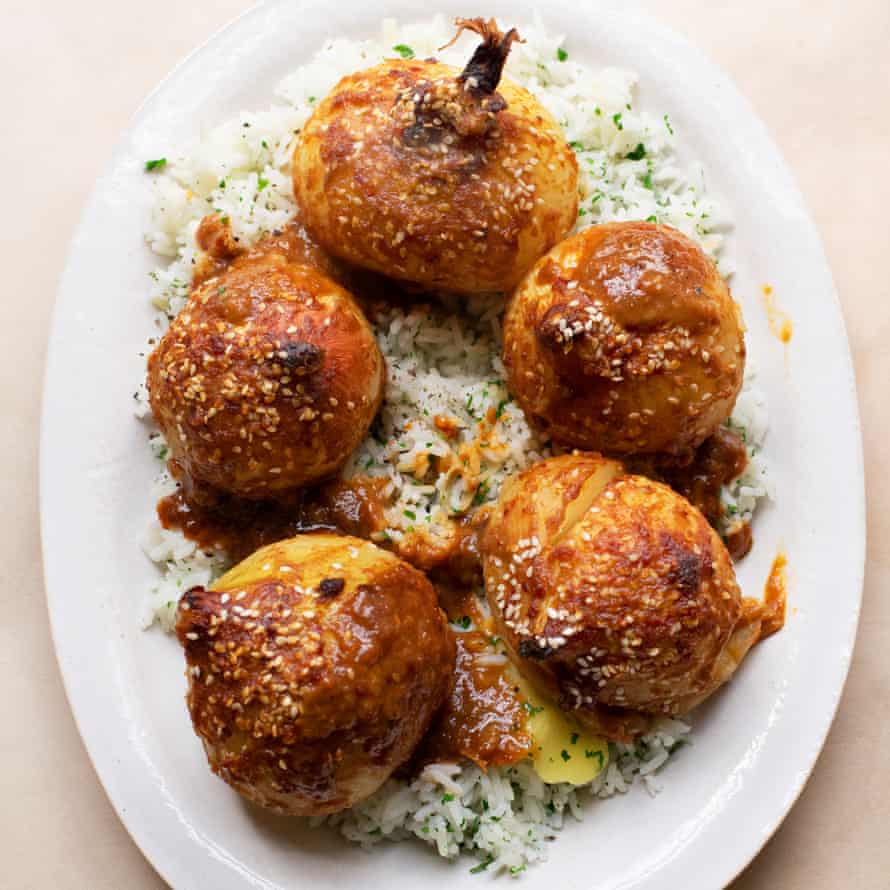 A dish of roast onions, bronze, sweet and hot, is one of those side dishes I have taken to serving as a main course. The inherent sweetness of their caramelised outer layers is a contrast to the deep, savoury quality of miso, and with a bed of brown rice this becomes a most satisfying dinner. It is essential to simmer them long enough in their bay-scented stock to render them on the point of collapse, each layer soft and giving, before putting them in the oven. The accompanying rice bolsters them up to a main course, but you could equally serve them with couscous or lentils. Serves 4 For the rice Bring a deep pan of water to the boil with the bay leaves and peppercorns. Set the oven at 180C fan/gas mark 6. Peel the onions, lower them into the boiling water then turn down the heat to a simmer. Leave for 25-30 minutes, until the onions are almost translucent and soft enough to pierce effortlessly with a skewer. Lift the onions out with a draining spoon and place them, just touching one another, in a roasting tin or baking dish. Peel the ginger and grate to a paste on a very sharp, fine-toothed grater. Scrape the ginger into a small bowl and stir in the sake or dry sherry, chilli flakes, syrup and miso. Blend in the lemon juice and 4 tbsp of warm water. Pour the resulting dressing over the onions, turning them over so they are glossily coated. Scatter the sesame seeds over the onions. Bake in the preheated oven for 40-45 minutes, occasionally basting with the juices from the baking dish. Wash the rice in three changes of warm water, swishing the rice around in the water with your fingertips – a strangely pleasing task. Drain the rice, tip into a small saucepan and cover with enough water to come 3cm above the rice. Add the bay and cardamom pods, cracking the pods open as you go, then drop in the piece of lemon peel. Bring the rice to the boil, lower the heat and cover with a tight lid. Leave to simmer for 10 minutes, then remove from the heat and leave, lid untouched, for a further 10. Peel and halve the cucumber, remove the central core and seeds, then cut the flesh into matchsticks. Roughly chop the parsley leaves and toss with the cucumber. Shake over a few drops of rice or wine vinegar. Remove the lid to the rice and run the tines of a fork through the grains to separate them, stir the parsley through the grains, then spoon on to deep plates. Place the onions on top, spooning any sauce over them, then scatter with the cucumber and parsley. Citrus and cashew nut salad (vegan)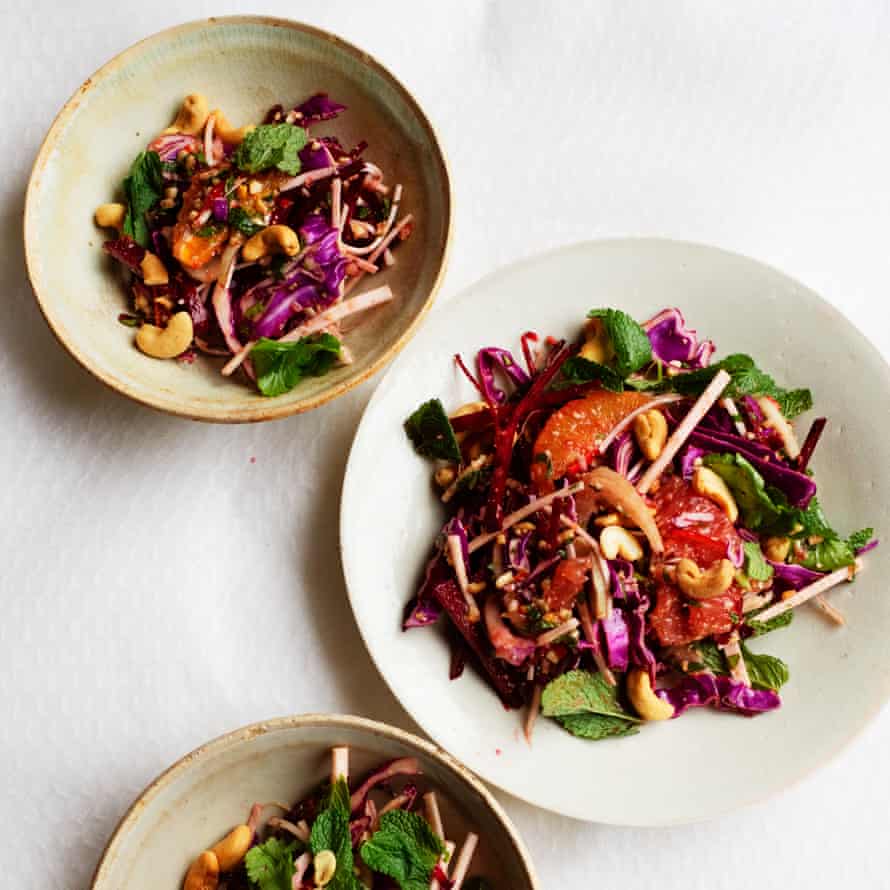 There is much to be said for a crisp refreshing salad even on an ice-cold day, if only to contrast all the warming, carbs-n-cheese suppers. The crunch here comes from the beetroot, red cabbage and celeriac, but you could use carrots or kohlrabi. (Broccoli stalks, thinly sliced, get my vote too.) It's a main course in my house, but would make a fine side dish too. The dressing sounds like a lot of trouble. It isn't. Everything just needs a quick blast in the blender or food processor – although I find the texture of the cashew nuts most pleasing when I grind them using a pestle and mortar, leaving them as a rough, gravelly powder. Once made, it is probably best to eat it the same day. Serves 4 For the dressing Make the dressing: put the vinegar, lime juice, olive oil and soy in a mixing bowl. Peel the ginger and grate it finely, then add to the liquids with the sugar. Finely chop the chilli (you can remove the seeds if you like a cooler dressing) and stir in. Crush the cashews to a coarse, nubbly powder with a pestle and mortar (or the end of a rolling pin), then add to the dressing with the mint leaves and the coriander leaves, torn up a little if they are particularly large. Stir the dressing and set aside. Remove the peel and white pith from the grapefruit and orange, saving as much juice as you can. Separate the segments with a sharp knife and add them to the dressing with any juice. Finely shred the red cabbage and fennel and add to the dressing. Peel the celeriac and beetroot, slice thinly, then cut into long, thin matchsticks. Toss with the dressing, check the seasoning and set aside for 30 minutes or more before serving. Add the reserved whole cashews just before bringing the salad to the table. Sweet potato and kimchi cakes (vegan) I sometimes make these little cakes with sweet potato alone, in which case a careful hand is needed, the mixture being particularly soft and sticky. To make them easier to deal with I now substitute a third of the sweet potato with maincrop white potatoes, instantly making them less fragile. The little cakes need 30 minutes in the fridge before cooking, in order to firm up. I suggest you let the underside brown crisply before turning – it contrasts with the soft centre and helps them hold together. A good crust makes them easier to turn too. You will need something to eat alongside, a crisp salad such as the garnet-hued roots and fruits above, or perhaps a bowl of chickpeas with a dressing of lemon, olive oil and parsley. Each time I make these I wonder if they would be a good candidate for filling a burger bun, with bushy emerald watercress and a squeeze of lemon. Makes 12, enough for 4 Put a deep pan of water on to boil, place a steamer basket or colander on top. Peel the potatoes and cut them into large chunks, as you might for roast potatoes, then put them in the steamer basket, cover tightly with a lid, and steam for 15-20 minutes. Peel the sweet potatoes, cut them into a similar size and add to the potatoes. Test the potatoes for tenderness – the sweet ones should be bright orange and easily pierced with a skewer or knife point. Remove them from the heat and leave for a few minutes until they have stopped steaming. Mash until quite smooth using a food mixer or a potato masher (but not a food processor, which will turn them to glue). Finely chop the kimchi and stir in. Chop the coriander leaves and stems and add to the mash with the flour. (You are unlikely to need pepper or salt.) Flour your hands very thoroughly, then take a small scoop of the mixture in your hand and pat gently into a small cake. Lay on a floured baking sheet or plate, re-flour your hands and repeat until the mixture is finished. You will have about 12 cakes. Chill the cakes in the fridge for 30 minutes. And please, don't miss this step because the cakes are fragile and they will collapse when you cook them. Warm a ½cm depth of the groundnut oil in a frying pan, then carefully lift the cakes, four at a time and fry for a minute or two over a moderately high heat until crisp on the bottom. Don't move them (or poke or prod them) until the underside is crisp. Now carefully flip the cakes over and cook the other side. As soon as the cakes are golden, lift out with a palette knife and rest on a plate and keep warm while you cook the rest – I like to use fresh oil for each batch. Serve the cakes as soon as they are all done, perhaps with a little more of the kimchi on top. Noodles with coconut and greens (vegan)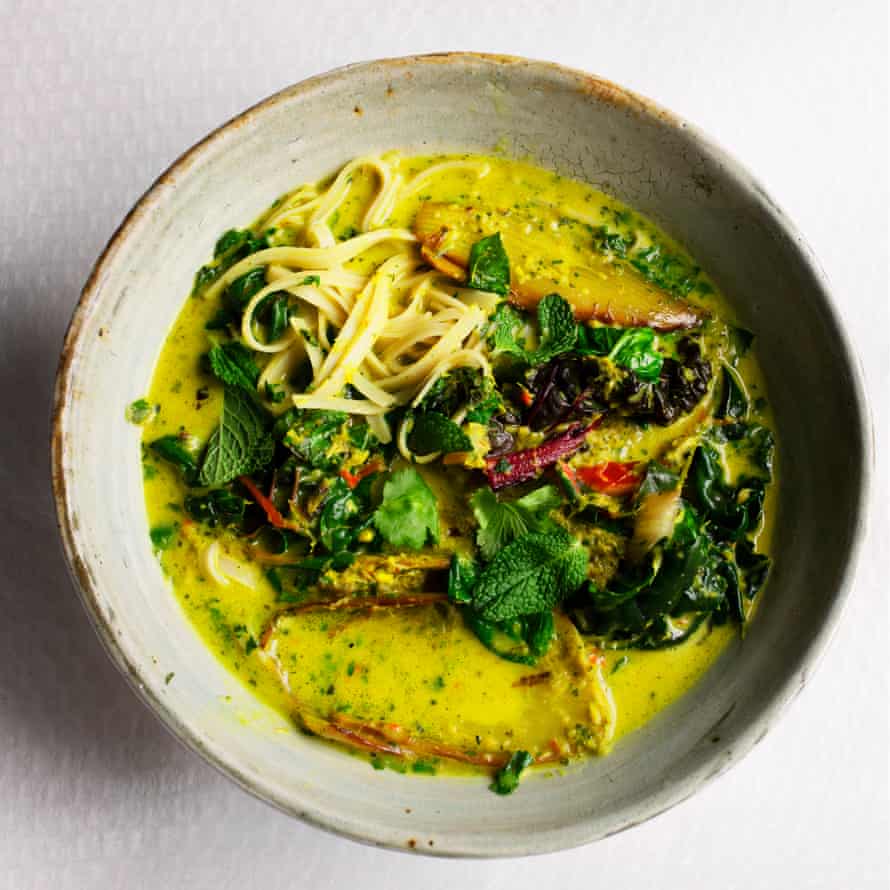 Comfort and spice. As the temperature drops, I relish those recipes that offer both the warmth of spice and the pacifying note of coconut milk. This one, a meal-in-a-bowl affair with ginger and chilli, noodles and greens, ticks every box for me. The inspiration are the soups I have eaten in Thailand, but the spicing is milder here, so up the chilli content if you wish. If the lime leaves prove elusive – as they so often do - make it anyway, perhaps including the zest of a lime instead. The effect is not quite the same, but good enough. Serves 4 For the soup Make the spice paste: peel and roughly chop the ginger, then put it into the bowl of a food processor. Add the garlic, chillies (minus their stalks), lemongrass (outer leaves discarded, the rest roughly chopped), and the spring onions and turmeric. Process for a few seconds, then add the coriander and the vegetable oil. Process for a few seconds to a coarse paste, scrape the sides down with a rubber spatula, then process briefly again. If the mixture refuses to soften to a paste, add a tablespoon of water. For the soup, peel the shallots and slice them in half lengthways. Warm the oil in a large casserole over a moderate heat, then add the shallots, cut side down together with a tablespoon of water, and let them cook for about 10 minutes, covered with a lid. Turn them from time to time and cook until almost tender. Add the spice paste and fry with the shallots for a couple of minutes, then add the stock, coconut milk and lime leaves. Leave to simmer for 10 minutes. Put the kettle on. Put the noodles in a large heatproof jug or a large bowl and pour the boiling water over them. Meanwhile, wash and trim the chard and spinach, then cut the stalks into fine shreds and add to the soup. Place the leaves on top of one another, roll up tightly and shred with a kitchen knife. As soon as the stalks are tender add the leaves, then the mint and coriander leaves. Drain the noodles, then use kitchen tongs to transfer them to four warm bowls. Ladle the sauce over the noodles and serve. Tomato couscous with harissa (vegan)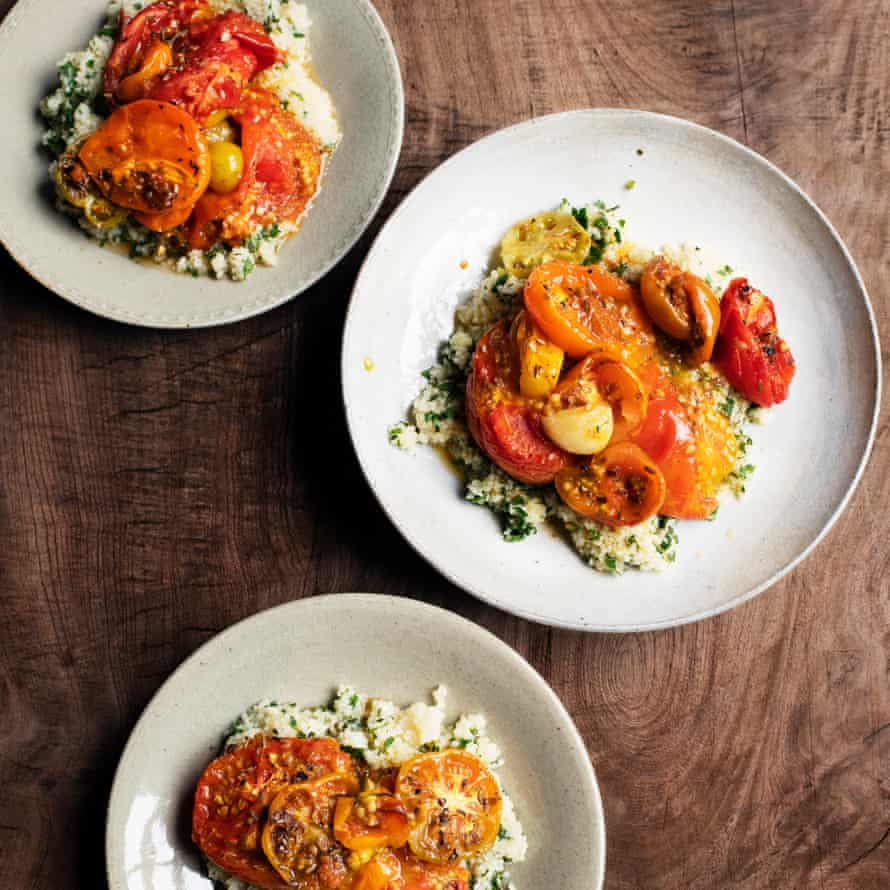 A favourite of mine, even when tomatoes are out of season. (Harissa paste does much for a less than sublime tomato.) It is worth mentioning that harissa pastes can vary slightly in heat so I suggest starting with a tablespoon then going on from there, to suit your taste. Making this with as many varieties of tomato as I can get hold of, the vibrant scarlets and oranges bring much cheer to a grey winter day. The couscous, though softly cosseting when soaked with rust-red juices could be swapped for rice if you prefer. Serves 3-4 For the couscous Cut the larger tomatoes in half and place in a roasting tin, tucking in the smaller ones. Add the garlic and olive oil. Peel and slice the red onion and add it to the tomatoes with a seasoning of salt and black pepper. Scatter the crushed cumin and coriander seeds over the tomatoes and onions. Roast at 180C fan/gas mark 6 for 35-40 minutes until the tomatoes are soft and the skins lightly browned. Bring the vegetable stock to the boil. Place the couscous in a heat-proof bowl, then pour the boiling stock over, cover and leave for 15 minutes. Remove the leaves from the mint and parsley and roughly chop. Use a fork to lightly crush the tomatoes so the juices bleed into the pan, then stir in the harissa paste. Run a fork through the couscous to separate the grains, then stir in the chopped herbs. Serve the roast tomatoes and their juices on top of the couscous. Chickpeas and macaroni (vegetarian)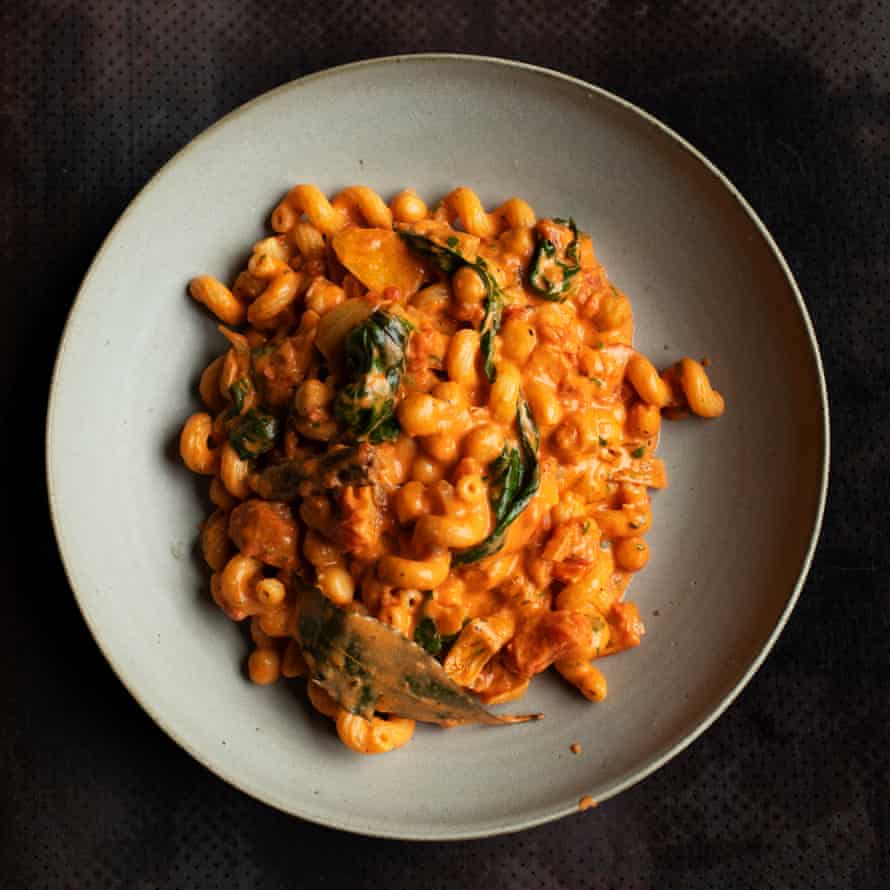 As much as I love spending time in the kitchen, I am ever grateful for quick recipes I can knock up in minutes. This one, pasta and pulses tied up in a mild, creamy tomato sauce, is one of those I make time and again. This is a pacifying dish, no real heat or pizzazz, just a warm and cosy pasta supper as effortless (almost) as a takeaway. Serves 2 Peel and roughly chop the onion, then soften it in a pan with the garlic and olive oil. When the onions start to brown, add the tomato purée, tinned tomatoes, cinnamon, bay leaves, chilli flakes and pepper and salt. Simmer for 15 minutes. Bring a deep pan of water to the boil, salt it, then cook the macaroni for 9 minutes, until tender. Drain the macaroni. Drain the chickpeas and stir both into the tomato sauce. Simmer for 5 minutes, then stir in the cream. Add the chopped parsley and the basil leaves. Divide the pasta and chickpeas between two deep bowls and serve. Roast spiced winter roots, haricot mash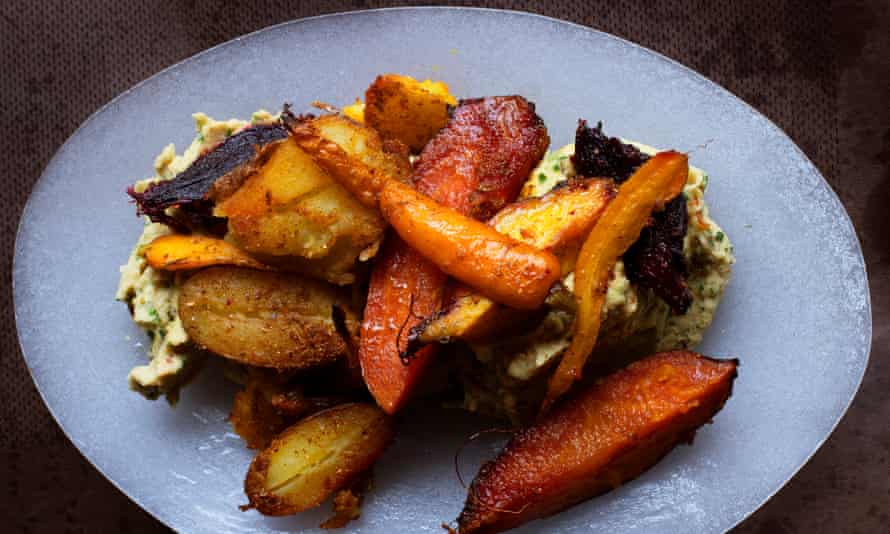 Sweet root vegetables – parsnips, carrots and beetroot – work well with spices such as cumin and coriander. Chilli too. I was introduced to this by the late Jane Grigson, with her almost legendary curried parsnip soup. Tossing the roots in the ground spices before roasting lends a mild warmth to the vegetables, but you could add more if you wish. Serves 4 (vegan) For the mash Peel and crush the garlic to a paste. Using a spice mill or pestle and mortar, crush the cumin and coriander seeds to a coarse powder, then mix in the salt and several grinds of black pepper. Add the chilli flakes and stir in the crushed garlic and oil. Set the oven at 180C fan/gas mark 6. Bring a couple of deep pans of water to the boil. Trim the beetroot, without breaking the skin, then put them in the water and let them cook for 25-30 minutes, depending on their size, until they are soft enough to pierce easily with a skewer. Cut the potatoes in half and add them to the second pan and boil them for 15 minutes. Drain the beetroot and cut them in half. If they are large, cut them into wedges. Drain the potatoes. Slice the carrots in half. Toss the carrots, beetroot and potatoes in the spiced oil then transfer to a roasting tin and bake for 35-45 minutes. (I like to turn each one over halfway through cooking so they get evenly browned.) To make the mash, drain the beans and put them in a small pan, just covered with water. Bring to the boil, then lower the heat and leave to simmer for 10 minutes. Drain and return the beans to the empty pan, add the olive oil, parsley leaves, a little black pepper and the lemon juice, then mash to a smooth purée with a potato masher or food processor. Pile the mashed beans on a serving dish, then place the roasted spiced roots on top and serve. Mushroom and dill tart (vegetarian)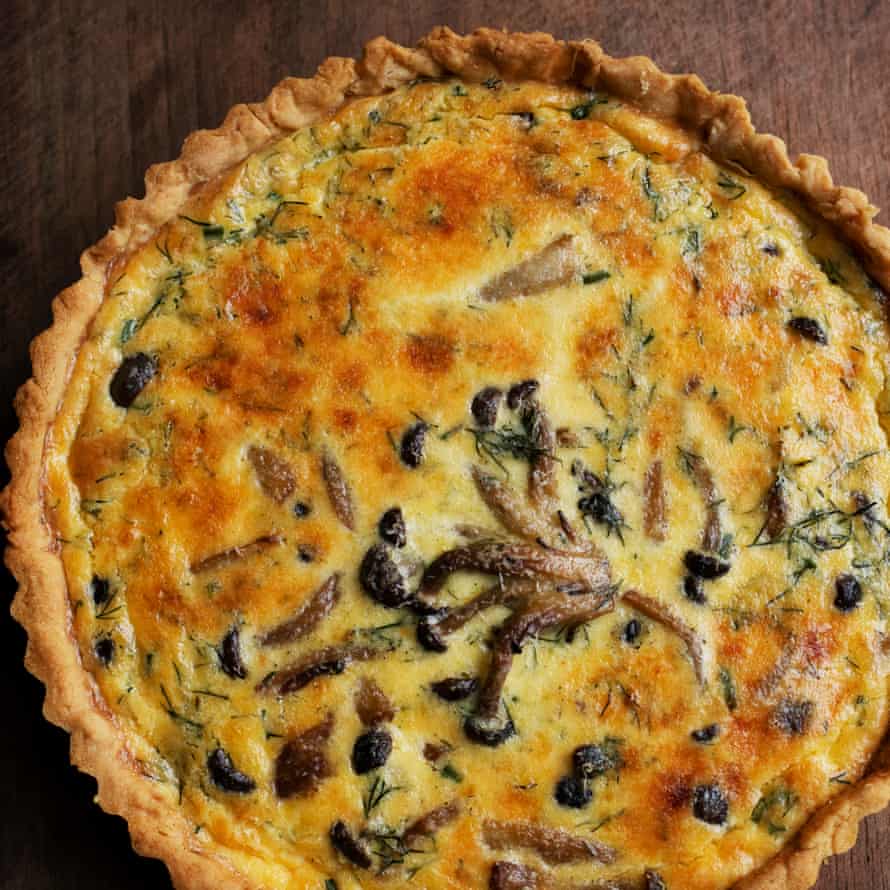 A classic tart but made with cheese pastry and a deeply savoury filling. I use small shimeji mushrooms for their flavour but buttons are good too, in which case I would slice them in half. If dill isn't your thing, then use tarragon which has similar aniseed notes, or leave out the herbs altogether. There are three distinct stages to this recipe – the pastry, the filling and the second baking, which I know feels offputting, but its crisp pastry and silky filling is worth every moment of your time. Serves 6 For the filling You will need a 22cm tart tin with a removable base. To make the pastry, cut the butter into cubes and rub it into the flour with your fingertips until it resembles coarse breadcrumbs. Mix in the egg yolk and parmesan, bringing the ingredients together into a firm ball of dough, adding a tablespoon or two of cold water if necessary. You can do this in seconds using a food processor. Tip the dough on to a lightly floured board and knead for 30 seconds or so (no longer) shaping it into a ball as you go. Wrap in clingfilm or greaseproof paper and chill in the fridge for 30 minutes. While the dough chills, make the filling. Pour the cream into a medium-sized saucepan, add the parmesan rind and bring to the boil. Remove the cream from the heat immediately when it starts to boil, then cover with a lid and set aside. Cut the mushrooms into small pieces. In a small frying pan, warm the oil then fry the mushrooms for 4 or 5 minutes, until slightly sticky. Chop the dill and toss with the mushrooms and set aside. Remove the dough from the fridge and tenderly roll into a disc large enough to line the tart case. Press the pastry into the edges, patching it where necessary. Make certain there are no tears or holes. Chill for 20 minutes, allowing the pastry to relax. Set the oven at 180C fan/gas mark 6 and place an upturned baking sheet on the middle shelf to heat up. Place a sheet of baking paper or foil on top of the pastry, fill with baking beans and slide into the preheated oven on top of the warm baking sheet. Bake for 25 minutes, then carefully remove the parchment and beans and return to the oven for a further 5 minutes until dry to the touch. Lower the heat to 160C fan/gas mark 4. Break the eggs into a bowl and beat gently, then add the cream (removing the parmesan rind). Season with salt and pepper, add the fried mushrooms, then spoon into the tart case and bake for 25 minutes. Chickpea and amaranth loaf (vegan) This started life as a stuffing, but recipes move on and what was once cooked inside a goose is now a dish in its own right. As much as I like a nut loaf, this softer version is less expensive to make and nicely balanced with a hint of sweetness from the dried fruits. You can make the mixture a day or more in advance. It will freeze, too. Cook it in a 20cm x 12cm parchment-lined loaf tin, then let it rest for a good 20 minutes before spooning or slicing. You will want something with this. I have served it with spinach, cooked quickly in a hot, covered pan and a few spoons of vegetable stock, or you could make a sauce for it. Mushroom perhaps or something spicier with tomatoes and chillies. Enough for 6 Peel and finely chop the onions. Warm 3 tbsp of the olive oil in a deep pan, add the onions and let them cook over a moderate heat for 15-20 minutes until they are soft and pale gold. Take care not to brown them. Peel and finely chop the garlic, stir it in, then add the cumin, coriander, chilli and a little black pepper. Bring a medium pan with 400ml of water to the boil, then rain in the amaranth and let it simmer, partially covered, for 15 minutes. Drain using a fine sieve. Put the pan back on the heat, add the chickpeas and their liquor and warm thoroughly. Chop the figs and apricots. Pull the leaves from the parsley. Remove the chickpeas from the heat then purée with the parsley leaves and remaining olive oil using a food processor. Set the oven at 180C fan/gas mark 6. Combine the chickpea and parsley purée with the drained amaranth, dried fruits, onions and garlic. Transfer to the loaf tin, smoothing the surface and taking care to push the stuffing into the corners. Bake for 25-30 minutes. |
|
Posted: 17 Jan 2021 12:00 AM PST My mother and I started Gujarati Rasoi on a market stall in Hackney, east London, in 2005. By 2012 we had a second stall in Borough Market. When Covid-19 happened we moved online. What is constant during this is our food. The recipes have been with my family across generations and continents, and remain unchanged. They are a culinary sutra, a link to our past.  My family is from a very rural region of Gujarat in India, a tiny village a two-hour rickshaw ride from the city of Surat, thus the food, known as Surati, has another tier of regionality to it. The vegan and vegetarian recipes here are a part of that heritage: we make these "everyday" recipes at least once a week. The spinach flavour is intensified by reduction and cooked with tempered spices and onion, the peanuts adding bite. The cumin complements the okra and the sour and spicy yoghurt soup. Gujaratis rarely have a meal without something sweet so I've included a recipe for lapsi, made with toasted broken wheat, fennel and cardamom. If the meal is made in its entirety (choosing either the palak or the binda) it will feed four. BindaOkra (binda) is a very easy recipe, a good start if you are new to making Indian food. Start with selecting the freshest okra – the way to do this is to bend one at the pointed end, if it snaps off, it's fresh. Serves 4 with the other dishes To clean the okra, rinse in warm water and leave to drain. You may want to do this next part in fours, cleaning each okra individually will otherwise take a long time. Lay the okra four at a time on a clean tea towel, then wipe them with a paper towel from top to end, turning them a quarter turn each time until all sides are cleaned. Repeat with all the okra. Again four at a time, line them up on a chopping board, cut off the tops and slice them into 2cm pieces and set aside. Put the oil in a wide frying pan and place over a medium heat. If you use a small pan the okra will not dry as it cooks, this will make it sticky and it will break. Test the oil by dropping a cumin seed into it, if it fizzes almost straight away it's hot enough. Add the cumin and allow it to sizzle for 4-5 seconds. Now add the okra and reduce to a low heat. Gently move the okra in the pan so it has a coating of oil and spread it out in the pan. Allow it to cook until it becomes almost tender. Move the okra so it cooks evenly while being careful not to break them. When the okra is almost tender, add the rest of the ingredients except the coriander and lemon juice, and cook for 5 minutes. Add the coriander and lemon juice. Remove from the heat and serve. Khaddi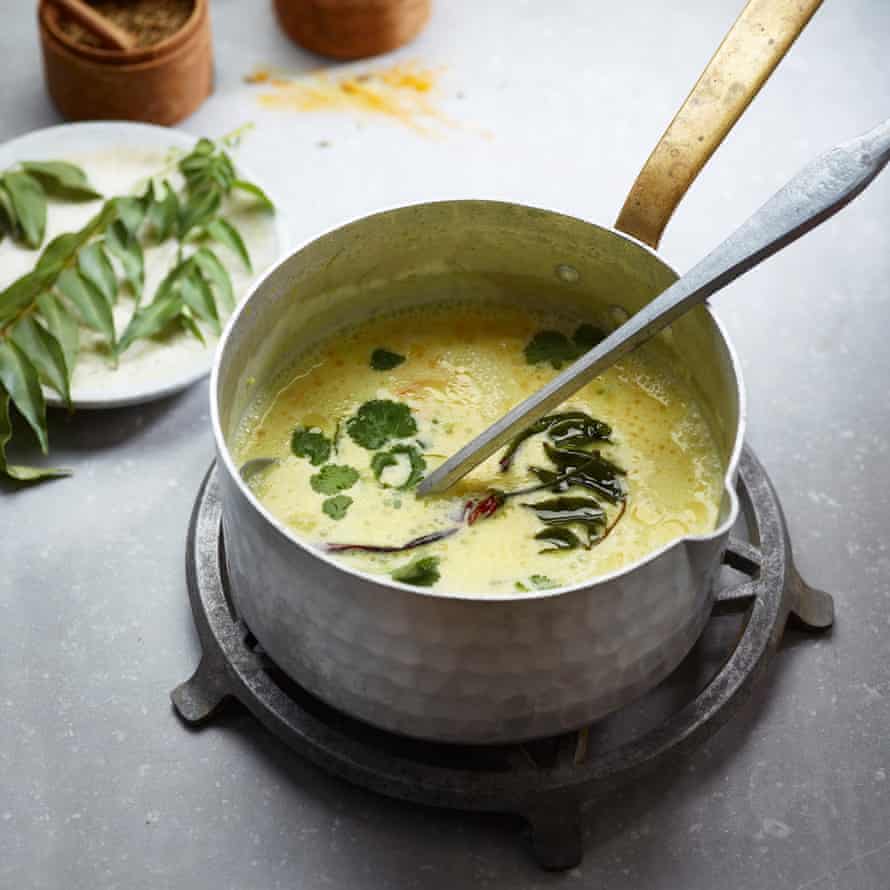 Khaddi is a delicious warming spicy, tangy, soup. Ideal for a cold blustery day. I like to leave the yoghurt standing for a couple of hours at room temperature to intensify its sour flavour – this improves the finished taste. Originally this would have been made with the buttermilk left over from making paneer. Serves 2 Add the yoghurt slowly to the gram flour, whisking gently until all the lumps are gone. Add to this the powdered or fresh turmeric and mix in completely. Now slowly mix in 330ml of water and set aside. Put a pan over a low heat, add the ghee or sunflower oil and the dried red chilli. Add one or two cumin seeds, if the ghee is hot enough the seeds will sizzle. If not, wait and try again. Once hot enough add the cumin, cloves and curry leaves. Keep a lid hovering over the pan as the cloves may pop out. Allow the spices to infuse the oil or ghee for around 15 seconds. Now add the yoghurt and water mixture so that the spices do not burn. Add the sugar, ginger and half the green chilli. Add almost all the salt, reserving a pinch of it. Keep stirring with a whisk and bring to a simmer, but do not allow it to come to a boil or it will cause the khaddi to curdle; it will thicken slightly. At this point adjust the consistency by adding more water if you prefer a thinner khaddi. Allow 4-5 minutes for the flavours to infuse, then taste. The khaddi should have a full tangy flavour, with cumin and ginger and lastly chilli in the background. If you like a little more heat add the rest of the chilli. Then wait for the flavours to infuse, taste again and add the rest of the salt to your taste. Just before serving, add a sprinkle of chopped coriander. Kitchdi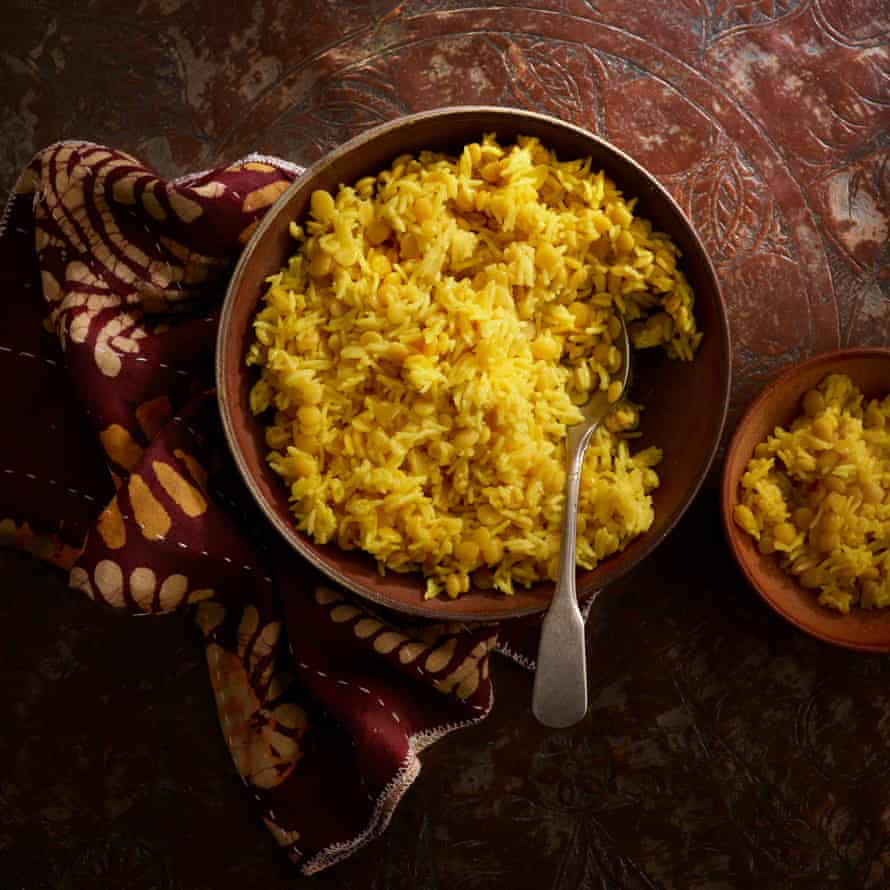 Serves 4 with the other dishes To serve Rinse the rice twice, drain and set aside. Rinse the toor dal twice and drain. Pour 400ml of the fresh water into a pan with the salt and add the dal. Bring to a boil, then reduce to a simmer with a lid partially on for 20 minutes. Add the rice, ginger, garlic and turmeric to the partially cooked pigeon peas and bring to a boil, then reduce the heat and simmer with the lid on for a further 20 minutes. Check at 5-minute intervals to make sure the rice is not catching, and add the rest of the water if needed. Rest the rice for 5-10 minutes with the lid on before serving. Serve with a little ghee or butter if you wish. Palak You can use broadleaf spinach or baby spinach here. Be sure to rinse it at least twice. If using broadleaf spinach, chop off the root, leaving as much of the stems as possible, then slice it into it at 4cm intervals, and set aside to drain in a colander. Serves 4 with the other dishes Place the ginger, chilli, ground coriander, ground cumin and turmeric in a bowl. Place a saucepan large enough to hold half the spinach in it on a low heat. Add the oil. Remove the skin from 3 or 4 of the peanuts, then put all the peanuts into the pan. They will slowly begin to crackle. Keep moving them so they fry evenly. Once the skinned peanuts are golden remove them all from the pan, leaving as much of the oil as possible. As the peanuts cool down, they will lose any moisture still in them and become crunchy. Now temper the cumin. Place the pan back on the heat and add a cumin seed – if it sizzles on contact then the oil is hot enough, so add the rest of the cumin. The cumin should fizz and begin to brown and release its flavour into the oil. Do not let it brown too much – if it is, remove the pan from the heat and go to the next step. Add the onion, which should cool down the pan a little and prevent the cumin overcooking. Fry the onion for a minute, then add the garlic. Once the garlic begins to brown, add the bowl of spices and mix it in with the onion. You have now made a masala – cook it for a minute, then add half the spinach and stir through. Place a lid on the pan until the spinach has wilted, then add the rest, thoroughly mix through and allow it to cook with the lid off. When all the spinach has wilted and nearly all the moisture in the pan has evaporated, it's ready. Lightly crush the peanuts in a pestle and mortar, scatter over the top of the spinach and serve. Lapsi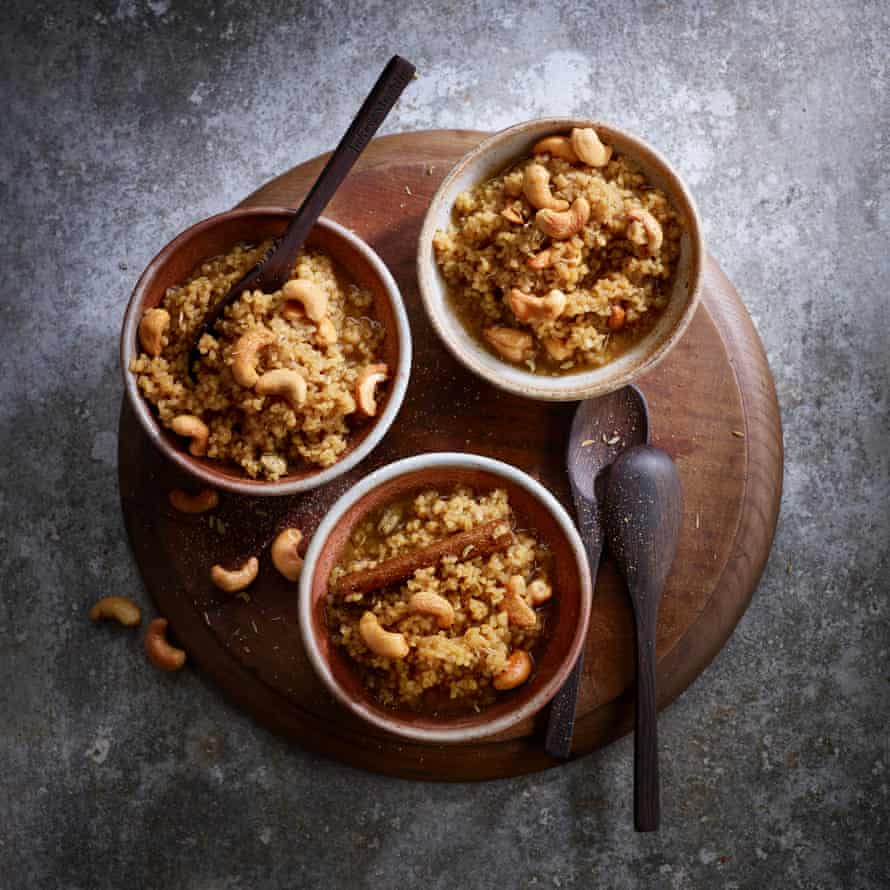 Serves 4 with the other dishes Dissolve the jaggery in the just boiled water and set aside. Place the ghee or coconut oil into a wide pan on a very low heat, add the nuts and toast them until they are golden, then remove and set aside. Press the cardamom a little to gently split it, but don't allow the seeds to burst out of their pods. Add the cardamom and cinnamon to the ghee or coconut oil for 1 minute. Now add the broken wheat and toast – the wheat should foam, if not, turn the heat up a little. After 1 minute remove from the heat then add the jaggery and water solution in one movement to the pan, this will cool down the wheat and stop it toasting. Be prepared for a lot of hot steam. Bring to a simmer and keep stirring for 20 minutes or until the water is almost all absorbed. Take the fennel seeds and gently "rough" them in a pestle and mortar, then add them to the lapsi. Remove from the heat, add the nuts and a pinch of freshly grated nutmeg, and serve hot. NOTE: I rarely use ghee or clarified butter, however, some of the older traditional recipes call for it. I use it sparingly for the flavour only. Prior to refrigeration, the best way to preserve butter was to clarify it. If you do not have any to hand, it is very easy to make. Put some unsalted butter in a pan and heat it on a low heat – the water content will evaporate and the solids will separate to form ghee. I like to let the solids brown a little as this imparts a lovely flavour, then remove from the heat, rest for 5 minutes, then pour off the liquid into a sterilised jar and keep in the fridge. Urvesh Parvais is the chef-owner of Gujarati Rasoi |
| You are subscribed to email updates from "vegetarian recipes" - Google News. To stop receiving these emails, you may unsubscribe now. |
Email delivery powered by Google |
| Google, 1600 Amphitheatre Parkway, Mountain View, CA 94043, United States | |
from What to Cook https://ift.tt/39YFAmp
